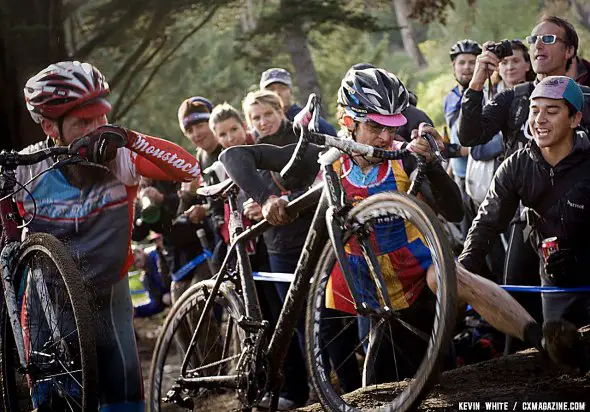
Pros lapping weekend warriors makes singlespeed racing a welcoming category for racers of all abilities, including our Dirtbag. © Kevin White
Cyclocross Magazine introduces a new semi-weekly op-ed column called “The Dirtbag,” an opinionated series by Cyclocross Magazine contributor Brooke Hoyer. Hoyer previously wrote “The Highs and Lows of Bottom Bracket Heights” for Issue 4, and we’re psyched to have him back. He describes his column as one “focused on equipment choice that is based on value, durability, and effectiveness.” While many of us might drool over the latest 14 pound carbon Di2 and disc brake-equipped cyclocross bike, we simply can’t afford such a dream machine, and Hoyer’s columns just might make us feel better about our current equipment.
The Dirtbag, Entry #2
When I finally get around to replacing my cyclocross race frame, I have a laundry list of things that it needs. The highlights are: disc brakes, 135mm rear spacing, generous tire clearance, and to be both singlespeed-ready as well as inexpensive. Oh, and I don’t want it to weigh a ton. The first two items in my list might be considered controversial, but I’m here to address the new technology haters, otherwise known as “traditionalists.”
Disc brakes are the future of cyclocross, at least in some parts of the world, where there is any combination of mud, snow, and ice. I currently have cantilever brakes, and they work great. I just don’t think discs are compelling enough to spend the capital in order to get a new frame when my current one is working just fine. But when it’s time to retire my valiant Eddy, I’ll go disco dancing. Discs are heavier than cantis, and the additional stopping power that discs provide isn’t absolutely necessary for cyclocross racing.
However, they excel when it comes to mud build up. Mud simply doesn’t accumulate on discs, whereas cantis provide a handy shelf for your mud and debris collection that appreciates with interest on each and every lap. I have raced courses where the mud and organic debris built an adobe house on my bike and caused significant drag at the brake arches. I’ve had the kind of build-up where it pays to stop and clear handfuls of crap from brake area. Discs pretty much fix this problem. There’s so much more clearance between the rim and fork and rim and frame when you get rid of those pads, and you can open up the area when you’re not designing around the width of a cantilever brake.
So let’s recap: discs are heavier than cantis but they are much lighter than cantis coated with bits and pieces of the course. Admittedly, junk can still get in between a pad and rotor, causing drag, but it’s not at the same level of a cantilever. In typical ’cross conditions, cantis will start the race lighter but finish the race much heavier.
If you race in dry conditions exclusively, you can eschew discs completely. However, most racing hotbeds are going to have some or many races in inclement weather where discs are going to be the right choice. Manufacturers are going to see disc-equipped bikes increasing in popularity and make more of them. You will be assimilated.
While I’ve preached the superiority of discs for racing, non-racer devotees of ’cross bikes are going to love discs. They are such the no-brainer option for non-racing applications, I probably don’t even need to waste words talking about it. But I will. First, you get the opportunity to design ’cross bikes with great tire clearance – think 1.9 or 2.0 29er tires on a ’cross bike. Couple that with better braking performance and you can get a monster ’crosser that can do almost anything. If your rides tend to be more urban and less trail, you are going to appreciate the better braking performance in traffic and foul conditions, plus replacing a rotor is a lot cheaper and easier than replacing a rim worn thin by road grit.
Manufacturers, who want to sell bikes, not just racing bikes, are going to discover that disc brakes are going to be the most popular option on cross bikes. It’s already happening. You will be assimilated.
Now that I have established the inevitability of disc brakes, I really need to say something about rear spacing. 135 mm. And that’s all there is to say about that.
No, seriously. What’s the debate? Mountain bikes have provided us with a plethora of 135mm-spaced disc hubs from which to choose. 29ers mean there are tons of choices for 135mm spaced 700c disc rear wheels from which to choose. Contrast that to the nearly nonexistent 130mm disc options. Okay, there is that new White Industries hub that looks pretty good but it isn’t cheap. Velocity markets a 130mm disc wheelset [Ed note. see our review in Issue 17]. Novatec makes a decent hub set. And Vuelta makes a line of heavy 130mm-spaced disc wheels. And that’s about it. Why in the world would you want to purchase a frame that requires that you wait around for a standard that may never really catch on?
I think there is only one last item to discuss regarding discs: cable versus hydraulic activation. Currently there is no comparison — cable. It looks like there are going to be a couple (maybe a handful) of hydraulic road disc levers on the market in the current year. All of them look to be expensive. You could get the external master cylinder to convert cable levers, but they’re not cheap either. I readily agree that hydraulic isn’t subject to cable friction and provides better feel and modulation. However, cable is simple and effective – and at least for the near term, way cheaper. Until there are affordable road hydraulic options in the market, cable actuated is going to be the rational choice.
You will be assimilated.
Did our resident Dirtbag read your mind or get your blood boiling? Drop a comment below. Got an itch to try singlespeed cyclocross racing? Check out our singlespeed conversion how-to and give the one-gear movement a try.




























